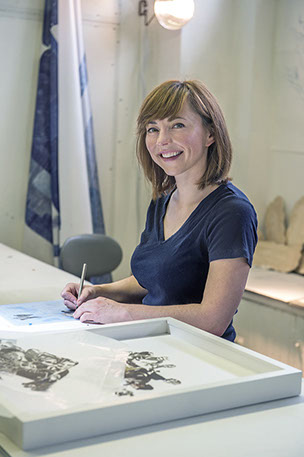Sarah Kabot
2017 Mid-Career Prize in VISUAL ARTS
If your mother works in advertising, your father is an engineer at General Motors and refurbishes antique boats, and your grandmother is a tailor, you’re probably going to grow up to be creative, as did Sarah Kabot.

“Everybody was making things with their hands and their minds, so that was just part of everyday life when I was a kid,” she says. “There weren’t a lot of children making art in school other than in classes, but I was one of the few dedicated in that direction.”
Pursuing art as a career became clearer between her sophomore and junior years of high school, when she attended the Interlochen Arts Camp. “I found my tribe of people there,” she reveals. “Although, it was still difficult to decide whether I wanted to attend college to pursue visual art or genetics, or a field of research science.”
Then she ran into the obstacle known as calculus, which challenged her commitment to science. "I also realized the boundaries to explore visual art freely were my own, rather than the constraints external research funding may place on my creative capabilities,” she adds.
Growing up outside of Detroit, she decided to enroll at the Art Institute of Chicago, where she learned a lot from the fiber artist faculty. However, after a year and a half, she transferred to the University of Michigan to save money for graduate school. Two years after earning her BFA in fiber and ceramics (1998), she attended Cranbrook Academy of Art in Detroit, where she earned her MFA in fiber (2002).
For Sarah, the pattern and similarity of the urban landscape, from buildings that house businesses, stores, residents and manufacturers to monuments and memorials, is a source of visual inspiration. “I’ve always been fascinated with the idea that the structure of those places all looks the same, but on the interior people have altered it to suit their own needs,” she explains. “I’ve done a lot of installations that deal with quotidian architecture, so seeing light fixtures, switches, plugs, conduit and those kinds of banal things as a point of focus and replicating them so that the audiences can see them in a newer, alternative way, intending for them to reevaluate the places they live in and move through.”
In the fall of 2003, she moved to Cleveland to join the faculty in the foundations department at the Cleveland Institute of Art, where her partner, Barry Underwood (CAP 2011), was a faculty member and chair of the photography department. Several years later, she was promoted to chair of the drawing department.
In 2006, she elevated her status as an elite artist with her solo exhibition at MOCA, the Museum of Contemporary Art Cleveland. Entitled, "Sarah Kabot: On the Flip Side,” the show featured a meticulously produced, intensely detailed paper installation that replicated the gallery’s ceiling and glass/steel wall, on a one-to-one scale.
“Sarah has a refreshing and brave way to make work,” says her close friend and fellow artist Corrie Slawson. “It’s incredibly skilled and detailed, too, and that amount of time and devotion to the subject honors the subject, and she does that beautifully in every body of her work.”
Since then, Sarah’s work has been shown at regional venues such as the Akron Art Museum, the Sculpture Center, and SPACES gallery, along with national and international exhibitions at venues including The Drawing Center in New York City, Peabody Essex Museum, (Salem, Mass.) Urban Institute for Contemporary Arts, (Grand Rapids, Mich.), and Tegnerforbundet, (Oslo, Norway). She has been in residence at the Headlands Center for the Arts, (Sausalito, Calif.), Vermont Studio Center (Johnson, Vt.), Sculpture Space, (Utica, N.Y.); Swing Space (New York City), Dieu Donne Papermill (New York City); and UCross, Wyo.
She completed two public commissions in Ohio in 2013, received a 2010 and 2015 Ohio Arts Council Individual Excellence Award, and a 2016 CAC Creative Workforce Fellow.
Sarah was a finalist for the prestigious West Prize (Philadelphia, 2010), received the 10th Annual Dave Bown Prize, and was a competitor in BRAVO’s 2011 reality television show Work of Art: The Next Great Artist. Her work is in the public collections of the West Collection, The Cleveland Clinic, and the Progressive Corporation. Her work has been reviewed in journals including Sculpture, The New York Times, and the Village Voice.
Cleveland Arts Prize
P.O. Box 21126 • Cleveland, OH 44121 • 440-523-9889 • info@clevelandartsprize.org